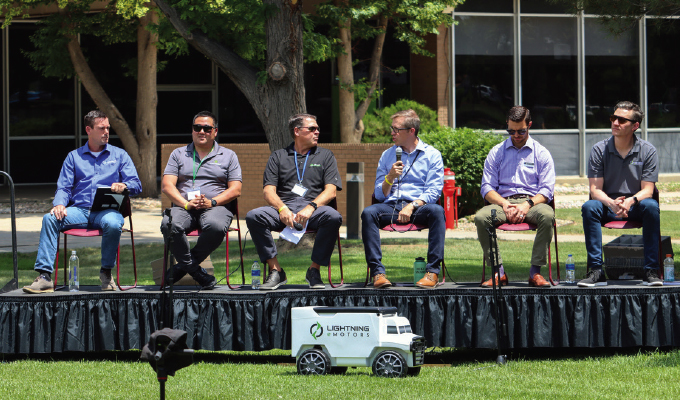Lightning eMotors makes electric vehicle (EV) solutions for the work truck industry in Classes 3-7. It also manufactures passenger solutions for Class 3-5 and 7-8 applications. Needless to say, Lightning eMotors has an EV solution for almost every fleet. Recently the company held an event, Lightning Day, in its hometown of Loveland, Colorado, with a ride and drive of its vehicles, a facility tour, and a panel discussion on “The Electrification Equation” that shares insight about challenges of fleet electrification and how to combat them. Read below to find out more.
Lightning eMotors builds zero-emission powertrains that integrate into OEM vehicles that customers know and love. With Lightning eMotors’ solutions in telematics, software, analytics, and charging infrastructure, these EV integrations are capable of supporting a variety of fleet needs. Because the company involves itself in every aspect of EV operation, fleet owners can focus more on their business and less on EV logistics.
Lightning eMotors wants all EV fleets to succeed. That’s why the panel at Lightning Day focused on challenges and how to face them.
FOCUS ON CHARGING
To discuss the first steps a fleet should take when considering EVs, Lightning eMotors invited Brody Ayers, an electric vehicle fleet program manager from Xcel Energy, a utility company in Colorado. Ayers explained that the first step is to have a conversation with the fleet’s electricity provider. He states that in Colorado, for example, utilities are required to create a vehicle electrification plan—and funding is often available for approved plans. Further, Xcel Energy offers a Fleet Electrification Advisory Program that helps fleets take a thorough look at their operations and decide which vehicles would make the most impact if converted to electric. Not every utility in the country has a Fleet Electrification Advisory Program; nevertheless, the utility company should be consulted before any EV plans are made, as the utility will be required to assist with charging infrastructure.
The utility is the first organization to contact when considering EVs, and Ayers says the second point of contact is the fleet’s facilities manager. With electric vehicles, the fleet’s fuel source is now within the fleet facility, which affects the company’s overall electricity usage. Not only that, the facilities manager will help determine what kind of charging infrastructure to implement, be it Level 1, which charges the slowest, Level 2, or Level 3, which charges the fastest.
GETTING THE EV
Once a charging infrastructure plan is in place, it’s time to find the electric vehicles. Companies looking to add EVs to their fleet have more options than buying an EV outright. To speak on this, Lightning eMotors invited Gary Van Orden, vice president of Mike Albert Fleet Solutions, a fleet management services company that also helps with vehicle leasing and funding. Van Orden explains that a leasing company can help fleets procure EVs in a few different ways. Mike Albert Fleet Solutions provides leasing via closed-end leasing and open-end leasing. This offers fleets the flexibility of carrying the risk of damage to the vehicle on their own or letting the leasing company carry the risk. Mike Albert Fleet Solutions will also partner with the fleet and the utility company to ensure a successful EV fleet for its customer.
NEXT MONTH
What’s the next step after planning charging infrastructure and getting an electric vehicle in the fleet? Find out next month in Outside the Cab!
Find out more, visit www.lightningemotors.com.




